
Get this – about 22,000 people every month are still Googling “How to start a blog,” according to Databox’s 2025 research. Crazy, right? Here I thought blogging was dead and buried.
I remember when I first started blogging five years ago, thinking I could just write whatever came to mind and expect traffic to pour in. My first blog post got exactly 3 views – and two of them were from my mom. I thought if I just wrote about what I had for breakfast, people would flock to read it. Spoiler alert: they didn’t.
Boy, was I wrong about everything! The landscape has changed completely. You can’t just wing it anymore and hope for the best.
Today’s successful bloggers get that content creation isn’t just about writing – it’s about solving real problems for your audience while building sustainable traffic and conversions. And here’s the kicker: only 20% of bloggers report “strong results” now, down from 30% five years ago. That makes picking the right topics more critical than ever.
Look, I’ve tested a ton of blog topics over the years. Here are the 25 that actually work. This guide breaks down high-performing topics across six strategic categories, each one evaluated for audience relevance, traffic potential, and business impact. Whether you’re struggling to drive consistent traffic or looking to optimize your content ROI, these blog ideas will help you create content that actually moves the needle.
From technical blog post ideas covering AI optimization to strategic business frameworks, you’ll discover proven blog topics that transform casual readers into qualified leads. And for businesses looking to stay ahead of the curve, understanding answer engine optimization becomes crucial for future-proofing your blog post ideas and ensuring maximum visibility across AI-powered search platforms.
Table of Contents
-
What To Look For When Picking Topics That Actually Work
-
Technology & AI Integration Topics (5 topics)
-
Business Strategy & Growth Topics (5 topics)
-
Content Marketing & SEO Topics (5 topics)
-
Paid Advertising & PPC Topics (4 topics)
-
Customer Retention & Email Marketing Topics (3 topics)
-
Industry Insights & Trends Topics (3 topics)
-
Performance Analysis: High-Impact vs. Quick-Win Topics
-
How The Marketing Agency Leverages These Topics
-
Final Thoughts
TL;DR
Here’s the deal – most people are picking blog topics based on what they feel like writing about. Bad move. The topics that actually drive traffic and leads require some strategy:
-
AI and technology topics show the highest growth potential with emerging search volumes
-
Data-driven business strategy content builds authority while generating high-value leads
-
SEO and content marketing topics provide consistent evergreen traffic opportunities
-
PPC and paid advertising content attracts high-intent commercial audiences
-
Customer retention topics demonstrate strong ROI potential with moderate competition
-
Industry trend content offers seasonal traffic spikes and thought leadership positioning
-
High-performance topics like LLM optimization offer exceptional results but need expertise
-
Quick-win topics including AI automation provide immediate traffic potential
-
Authority-building topics establish long-term credibility and expertise
What To Look For When Picking Topics That Actually Work
Before you write a single word, you need to figure out what your audience is actually searching for. Not what you think they should be searching for – what they’re actually typing into Google at 2 AM when they can’t sleep because their marketing isn’t working.
Keyword research tools reveal search volume trends, competition levels, and the intent behind user queries. But here’s what most people miss – the best blog topics solve genuine problems your readers face, not just what you want to write about.
When you’re evaluating potential blog topic options, ask yourself: does this solve a specific pain point that keeps your target audience awake at night? Will this actually help them do their job better, make more money, or avoid getting fired? If the answer’s no, move on.
Content performance goes way beyond simple traffic metrics. You need to think about whether your blog post ideas will generate engagement, social shares, and most importantly – conversions that actually matter to your business.
Will this content still be relevant next year (evergreen) or are you just chasing whatever’s trending on Twitter this week? And how does it fit into your conversion pathways? There’s no point getting traffic that doesn’t lead anywhere.
|
What To Look For |
High Priority Topics |
Medium Priority Topics |
Low Priority Topics |
|---|---|---|---|
|
Search Volume |
10,000+ monthly searches |
1,000-10,000 monthly searches |
<1,000 monthly searches |
|
Competition Level |
Low-Medium (you can actually rank) |
Medium (needs expertise) |
High (good luck with that) |
|
Business Alignment |
Directly connects to your services |
Indirect lead generation |
Brand awareness only |
|
Resource Requirements |
Matches your expertise |
Requires skill development |
Way beyond your capabilities |
|
Conversion Potential |
High commercial intent |
Mixed intent signals |
Primarily informational |
|
Content Longevity |
Evergreen with updates |
Seasonal relevance |
Short-term trend |
Here’s something nobody talks about – resource requirements vary dramatically between topics. Some need extensive research, expert interviews, or fancy multimedia elements. Others you can bang out in an afternoon with existing knowledge. Match your topic choices to your available time, expertise, and budget. Don’t bite off more than you can chew.
Brand alignment ensures your content naturally leads readers toward your products or services. Every blog topic should support your business objectives, creating a logical path from content consumption to customer acquisition. If you can’t draw a line from your blog post to your bank account, why are you writing it?
Measurable outcomes separate successful content from vanity metrics. Pick topics that let you track meaningful results like organic traffic growth, lead generation, brand visibility improvements, and customer acquisition costs. If you can’t measure it, you can’t improve it.
Technology & AI Integration Topics

These five technology-focused topics capitalize on the growing intersection of AI and marketing. From marketing automation to LLM optimization, these topics position you at the forefront of digital marketing evolution while addressing critical business needs. And honestly? Most of your competitors are still trying to figure out what ChatGPT even does.
1. AI-Powered Marketing Automation
ChatGPT has completely changed content creation workflows. Marketers are now generating blog outlines, social media posts, and email sequences at scale. This represents one of the most practical blog ideas for businesses looking to streamline their content production without hiring an army of writers.
Predictive analytics tools analyze customer behavior patterns to optimize campaign timing and messaging automatically. It’s like having a crystal ball, except it actually works and doesn’t require you to wear weird robes.
TechStart Solutions implemented AI-powered email automation that analyzes customer engagement patterns to determine optimal send times for individual subscribers. Their open rates jumped from 18% to 31% within three months, while their email-to-conversion rate improved by 47%. The AI system automatically adjusts subject lines, content length, and call-to-action placement based on recipient behavior history, resulting in $2.3 million additional revenue annually from their existing email list. Not too shabby for letting robots do the heavy lifting.
Automated email sequences powered by machine learning adapt to individual subscriber preferences, improving open rates and conversions. Marketing automation platforms integrate AI to score leads, segment audiences, and trigger personalized campaigns based on user actions. It’s personalization at scale without the manual work that makes you want to cry.
Why this topic works: High search volume driven by AI adoption trends, strong conversion potential as businesses desperately need automation solutions, requires technical expertise (which creates barriers to entry), aligns perfectly with data-driven marketing approaches, and offers measurable ROI through efficiency gains.
2. LLM Optimization Strategies
Large language models are reshaping how search engines understand and rank content. Most people have no idea this is happening, which means you can get ahead of the curve before everyone else catches on.
Understanding the fundamentals of LLM optimization provides the foundation for implementing advanced strategies that ensure your content remains discoverable and authoritative in AI-powered search environments. Because let’s face it – if AI can’t understand your content, you’re screwed.
Content optimization for LLMs requires understanding how these systems process information differently than traditional search algorithms. Schema markup, clear hierarchical structure, and semantic relationships between topics become crucial ranking factors. It’s not just about keywords anymore – it’s about context and meaning.
Positioning for AI-generated search results means creating content that AI systems can confidently cite and reference. This includes fact-checking, source attribution, and maintaining expertise, authoritativeness, and trustworthiness (E-A-T) signals. Basically, don’t make stuff up and expect to get away with it.
Why this topic works: Emerging high-value niche with virtually no competition right now, requires specialized technical knowledge (hello, barriers to entry), offers strong future-proofing potential as AI search evolves, and positions you as an early adopter in a rapidly growing field.
3. Marketing Attribution in a Cookieless World
First-party data collection becomes essential as third-party cookies disappear. This critical blog topic addresses one of the most pressing challenges facing digital marketers today – and most of them are panicking about it.
Progressive profiling techniques gather customer information gradually without overwhelming users with forms longer than a CVS receipt. Customer data platforms (CDPs) centralize data from multiple touchpoints, giving you a complete picture instead of scattered fragments.
Server-side tracking maintains measurement accuracy by processing data on your servers rather than relying on browser-based tracking. Google Analytics 4’s server-side implementation provides more reliable attribution data while respecting user privacy preferences. It’s more work upfront, but it actually works.
Multi-touch attribution modeling helps businesses understand the complete customer journey across channels. Advanced models weight different touchpoints based on their influence on conversions, providing clearer ROI insights for marketing investments. No more guessing which campaigns actually drive results.
Why this topic works: Critical business need as privacy regulations expand, high search intent from marketing professionals who are scrambling to adapt, technically complex requiring expertise, strong lead generation potential for consulting services, and excellent alignment with data-driven positioning.
4. Automation vs. Human Creativity in Marketing
Automated bid management systems optimize ad spend in real-time, but human oversight ensures strategic alignment with business goals. AI excels at processing data and making micro-adjustments, while humans provide creative strategy and brand voice consistency. It’s not about replacement – it’s about collaboration.
AI content generation tools accelerate production but require human editing for brand voice, accuracy, and emotional resonance. The most successful approaches combine AI efficiency with human creativity and strategic thinking. Because let’s be honest – AI-generated content without human oversight often sounds like it was written by a robot having a bad day.
Programmatic ad buying automates media placement and optimization, yet human creativity drives compelling ad concepts and messaging. Customer service chatbots handle routine inquiries while human agents manage complex issues requiring empathy and problem-solving.
Why this topic works: Balanced philosophical topic with moderate search volume, high social engagement potential addressing widespread concerns about AI replacing humans, moderate complexity requiring case studies, strong brand fit addressing client automation questions, and measurable through performance comparisons.
5. Real-Time Campaign Optimization Techniques
Dynamic bid adjustments respond to performance data in real-time, increasing bids for high-converting audiences while reducing spend on underperforming segments. This represents one of the most actionable blog post ideas for performance marketers seeking immediate results instead of waiting weeks to see what’s working.
Machine learning algorithms identify patterns humans might miss, optimizing campaigns continuously. It’s like having a tireless assistant who never sleeps and never makes emotional decisions based on gut feelings.
Automated A/B testing runs multiple creative variations simultaneously, automatically allocating budget to winning combinations. Advanced platforms test headlines, images, and calls-to-action across different audience segments for maximum impact. No more manual testing that takes forever to reach statistical significance.
Machine learning-driven creative optimization analyzes which visual elements, messaging, and formats perform best for specific audiences. These systems continuously refine creative elements based on engagement and conversion data.
Why this topic works: High commercial intent from performance marketers, moderate competition in technical optimization space, requires case studies and hands-on experience, strong ROI demonstration potential, and excellent service alignment for performance marketing agencies.
Business Strategy & Growth Topics
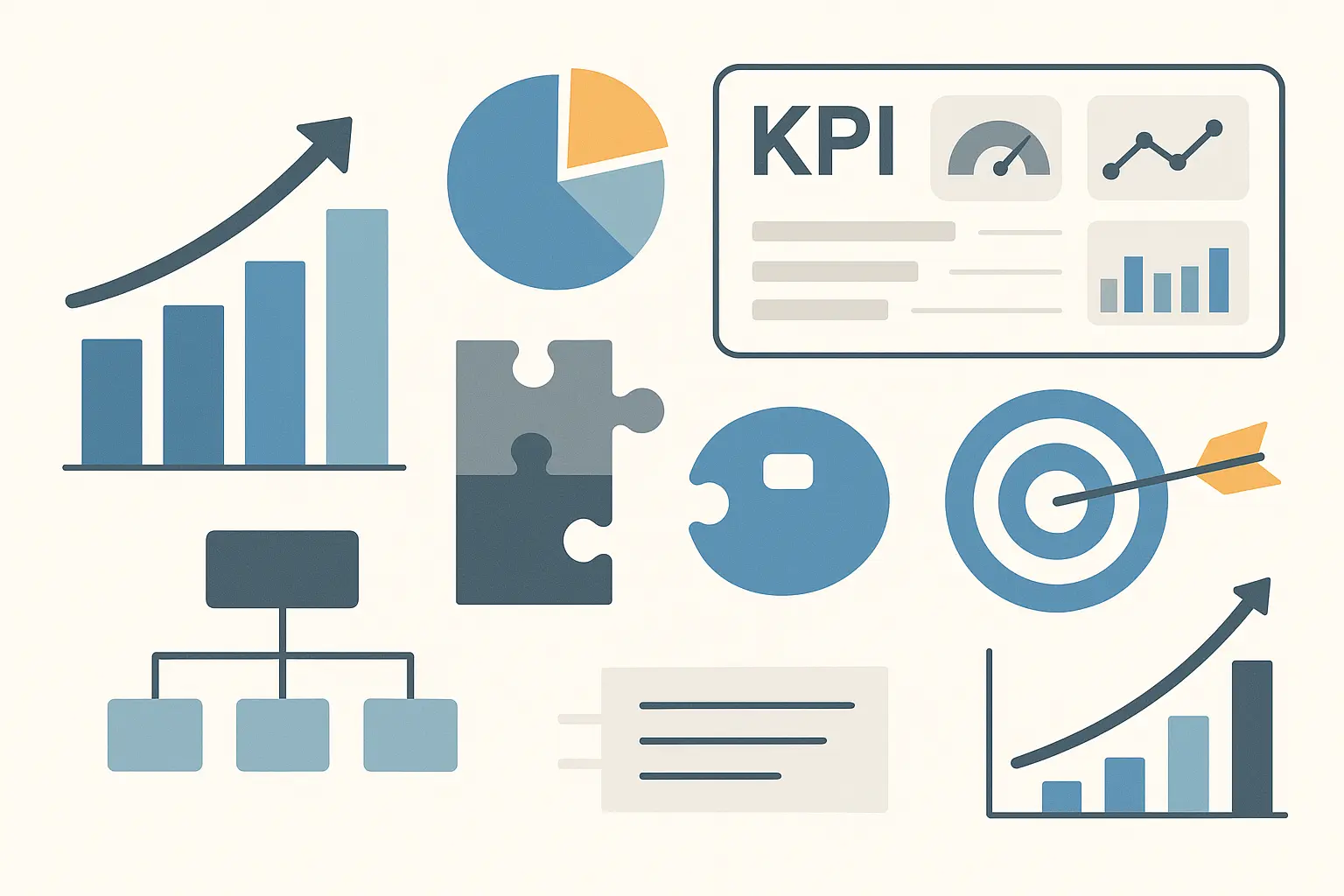
These five strategic topics focus on data-driven decision-making and scalable growth frameworks that actually resonate with business leaders and marketing executives. Each topic builds authority while generating high-value leads through comprehensive methodologies and practical implementation guidance. No fluff, just stuff that works.
6. Data-Driven Decision Making Frameworks
Effective data-driven frameworks start with clear objective definition and relevant KPI selection. This foundational approach represents one of the most valuable blog topics for business leaders who are tired of making decisions based on gut feelings and hoping for the best.
Here’s the thing – businesses often track vanity metrics instead of actionable data points that directly impact revenue and growth. These strategic blog ideas help executives transform raw data into actionable insights that drive real business outcomes instead of just looking impressive in PowerPoint presentations.
Data interpretation requires understanding statistical significance, correlation versus causation, and contextual factors that influence results. Raw numbers tell incomplete stories without proper analysis and business context. Just because your website traffic went up doesn’t mean your marketing is working if none of those visitors are buying anything.
Action planning transforms insights into measurable outcomes through hypothesis formation, testing protocols, and implementation timelines. Successful frameworks include feedback loops for continuous improvement and strategy refinement.
Why this topic works: High business value content with evergreen appeal, moderate search volume from executives and managers, builds significant authority and thought leadership, strong lead generation potential for consulting services, and excellent alignment with scientific methodology positioning.
7. ROI Measurement for Digital Marketing
7. ROI Measurement for Digital Marketing
Customer acquisition cost (CAC) calculations must include all marketing touchpoints, from initial awareness through final conversion. This critical blog topic addresses one of the most pressing needs for growing businesses – figuring out if their marketing actually makes money or just burns through cash.
Many businesses underestimate true acquisition costs by ignoring indirect marketing influences and longer sales cycles. These analytical blog post ideas help businesses understand the complete cost structure of customer acquisition across all marketing channels, not just the obvious ones.
GrowthTech Inc. discovered their true customer acquisition cost was 340% higher than initially calculated when they implemented comprehensive attribution tracking. Their original CAC calculation only included direct ad spend ($150 per customer), but comprehensive tracking revealed additional costs: content creation ($75), email marketing tools ($25), sales team time ($180), and marketing operations overhead ($80), bringing their true CAC to $510. This insight led them to restructure their pricing strategy and optimize their highest-ROI channels, ultimately reducing their comprehensive CAC to $380 while maintaining growth targets. Turns out, knowing your real numbers actually helps you make better decisions. Who would’ve thought?
Marketing mix modeling reveals how different channels work together to drive conversions. Advanced attribution models weight touchpoints based on their actual influence rather than simple first-click or last-click attribution. Lifetime value calculations help businesses understand long-term customer profitability and optimize acquisition spending accordingly.
Why this topic works: High commercial intent searches from business decision-makers, consistent demand from growing companies, requires analytical expertise and tool knowledge, excellent lead qualification potential, and perfect alignment with ROI-focused positioning.
8. Scaling Strategies for Growing Businesses
Team expansion requires strategic hiring plans that anticipate growth needs while maintaining company culture. Successful scaling involves creating systems and processes that work independently of individual team members. Because if your business falls apart when one person goes on vacation, you don’t have a business – you have a very expensive hobby.
System optimization becomes critical as transaction volumes increase. Automation tools, workflow management, and performance monitoring prevent bottlenecks that could limit growth potential. Quality maintenance during rapid expansion challenges many businesses. Standardized procedures, training programs, and quality control measures ensure consistent service delivery as teams grow.
Why this topic works: High-value audience of growing businesses, strong conversion potential for consulting services, evergreen content with broad appeal, positions comprehensive business expertise, and measurable through client growth metrics.
9. Market Analysis and Competitive Intelligence
Competitive analysis tools like SEMrush and Ahrefs reveal competitor content strategies, keyword targets, and backlink profiles. Social listening platforms monitor brand sentiment and identify market conversations your competitors might be missing. These strategic blog ideas help businesses gain competitive advantages through comprehensive market intelligence gathering instead of just guessing what the competition is up to.
Market gap identification requires analyzing competitor weaknesses, underserved customer segments, and emerging trends. Successful businesses position themselves in spaces where demand exists but competition remains limited. It’s like finding a parking spot in a crowded city – you need to know where to look.
Trend forecasting combines industry reports, Google Trends data, and social media analysis to predict market shifts. Early trend adoption provides competitive advantages and market positioning opportunities.
Why this topic works: Consistent demand from strategic planners and consultants, moderate competition requiring unique insights, builds credibility and thought leadership, requires ongoing updates and research, and strong alignment with strategic consulting services.
10. Performance Marketing Budget Allocation
Scientific budget allocation starts with baseline performance measurement across all marketing channels. Historical data reveals which channels drive the highest quality leads and conversions at different spending levels. No more throwing money at Facebook ads because that’s what everyone else is doing.
Testing methodologies include incremental budget tests, channel pause experiments, and cross-channel attribution analysis. These approaches reveal true channel performance and optimal spending distributions. I’ve seen businesses discover their “best performing” channel was actually just getting credit for conversions driven by other channels.
Reallocation triggers help businesses shift budgets dynamically based on performance changes, seasonal trends, and market conditions. Automated rules and manual review processes ensure optimal resource allocation without constant babysitting.
Why this topic works: High commercial value for performance marketers, specific search intent from budget decision-makers, requires case studies and hands-on experience, strong service alignment for marketing agencies, and measurable through improved ROI metrics.
Content Marketing & SEO Topics

These five SEO-focused topics are the bread and butter of organic growth. I’ve seen too many businesses throw money at ads while completely ignoring SEO – then wonder why their traffic disappears the moment they stop paying. Don’t be that business.
11. SEO for Long-Term Sustainable Growth
Look, I get it. SEO feels overwhelming. There’s technical stuff, content stuff, and a million “experts” telling you different things. But here’s what actually matters: your website needs to work properly, and your content needs to answer real questions people are asking.
Technical SEO sounds scary, but it’s really just making sure Google can read your website. Think of it like organizing your closet – if everything’s a mess, you can’t find anything. Same with search engines. Core Web Vitals, mobile optimization, schema markup – these aren’t just buzzwords. They’re the difference between ranking on page one or page ten.
Content clusters are where things get interesting. Instead of writing random blog posts and hoping for the best, you create a hub of related content. It’s like being the go-to person for a specific topic. Google notices when you consistently provide comprehensive coverage of a subject.
Advanced practitioners should explore knowledge graph optimization as part of their comprehensive SEO strategy, ensuring content entities are properly structured and interconnected for maximum search engine understanding and improved blog post ideas performance.
The E-A-T thing (Expertise, Authoritativeness, Trustworthiness) isn’t just Google being picky. Would you trust medical advice from someone with no credentials? Neither would Google’s algorithm. Show your expertise, cite your sources, and be honest about what you know and don’t know.
Why this topic works: Everyone wants organic traffic, it’s evergreen content that stays relevant, and once you rank, you can get traffic for years without paying for ads.
12. Content Strategy That Converts
Here’s where most people mess up – they create content that gets traffic but doesn’t make money. Traffic is nice, but revenue pays the bills.
Your content needs to match where people are in their buying journey. Someone just learning about a problem needs different content than someone ready to buy. I learned this the hard way when I spent months writing advanced tutorials for beginners who just wanted simple explanations.
Content funnel optimization ensures smooth transitions between content pieces, with clear calls-to-action and logical next steps. Landing page alignment, lead magnets, and nurture sequences work together to maximize conversion rates.
The conversion part isn’t about being pushy – it’s about being helpful at the right time. When someone’s reading about “how to choose email marketing software,” that’s your moment to mention your email marketing services. Natural, helpful, not weird.
Why this topic works: Businesses desperately need content that actually drives sales, not just vanity metrics like page views.
13. Keyword Intelligence and Research Methodologies
Keyword research is like detective work, except instead of solving crimes, you’re solving the mystery of what people actually search for. And trust me, it’s rarely what you think.
|
Keyword Type |
What It Looks Like |
Why It Matters |
Content Strategy |
|---|---|---|---|
|
Head Terms |
“marketing” |
Massive competition, low conversion |
Good for brand awareness, terrible for sales |
|
Long-tail Keywords |
“email marketing software for small restaurants” |
Lower competition, higher conversion |
This is where the money is |
|
Question Keywords |
“how do I segment my email list” |
People want answers |
FAQ content, how-to guides |
|
Commercial Intent |
“best CRM software 2024” |
Ready to buy |
Product comparisons, reviews |
Long-tail keyword mining reveals specific search queries with lower competition and higher conversion potential. These keywords often indicate stronger purchase intent and provide easier ranking opportunities for newer websites.
The tools are important, but understanding search intent is everything. Someone searching “CRM software” might be researching for their boss, while someone searching “CRM software free trial” is probably ready to test something out.
Competitive keyword gap analysis identifies opportunities where competitors rank but you don’t. These gaps represent immediate optimization opportunities with proven search demand and commercial value.
Why this topic works: It’s foundational knowledge that every content creator needs, and it directly impacts traffic and revenue.
14. Behavioral Insights for Content Creation
This is where things get fun. You can actually see how people use your content – where they click, how far they scroll, where they get bored and leave.
Heatmaps are like X-ray vision for your website. I remember discovering that people were completely ignoring my carefully crafted introductions and jumping straight to the bullet points. Guess what got shorter after that?
Content consumption patterns vary by audience segment, device type, and traffic source. Understanding these patterns helps optimize content length, format, and distribution timing for specific audience preferences.
The data tells stories your assumptions can’t. Maybe your audience prefers short paragraphs on mobile but longer explanations on desktop. Maybe they love videos but hate autoplay. You won’t know until you look.
Why this topic works: It bridges the gap between content creation and user experience, which is increasingly important for both SEO and conversions.
15. Multi-Channel Content Distribution
Creating great content is only half the battle. The other half is getting people to actually see it. One blog post can become a LinkedIn article, Twitter thread, YouTube video, podcast episode, and email newsletter. Work smarter, not harder.
Each platform has its own personality. What works on LinkedIn (professional, longer-form) bombs on Twitter (quick, punchy, conversational). Adapt your content to fit the platform, don’t just copy-paste everywhere.
Cross-channel amplification coordinates content promotion across platforms for maximum impact. Email newsletters, social media, and paid promotion work together to extend content reach and engagement.
Why this topic works: Most people create content once and hope for the best. This shows them how to multiply their reach without multiplying their work.
Paid Advertising & PPC Topics
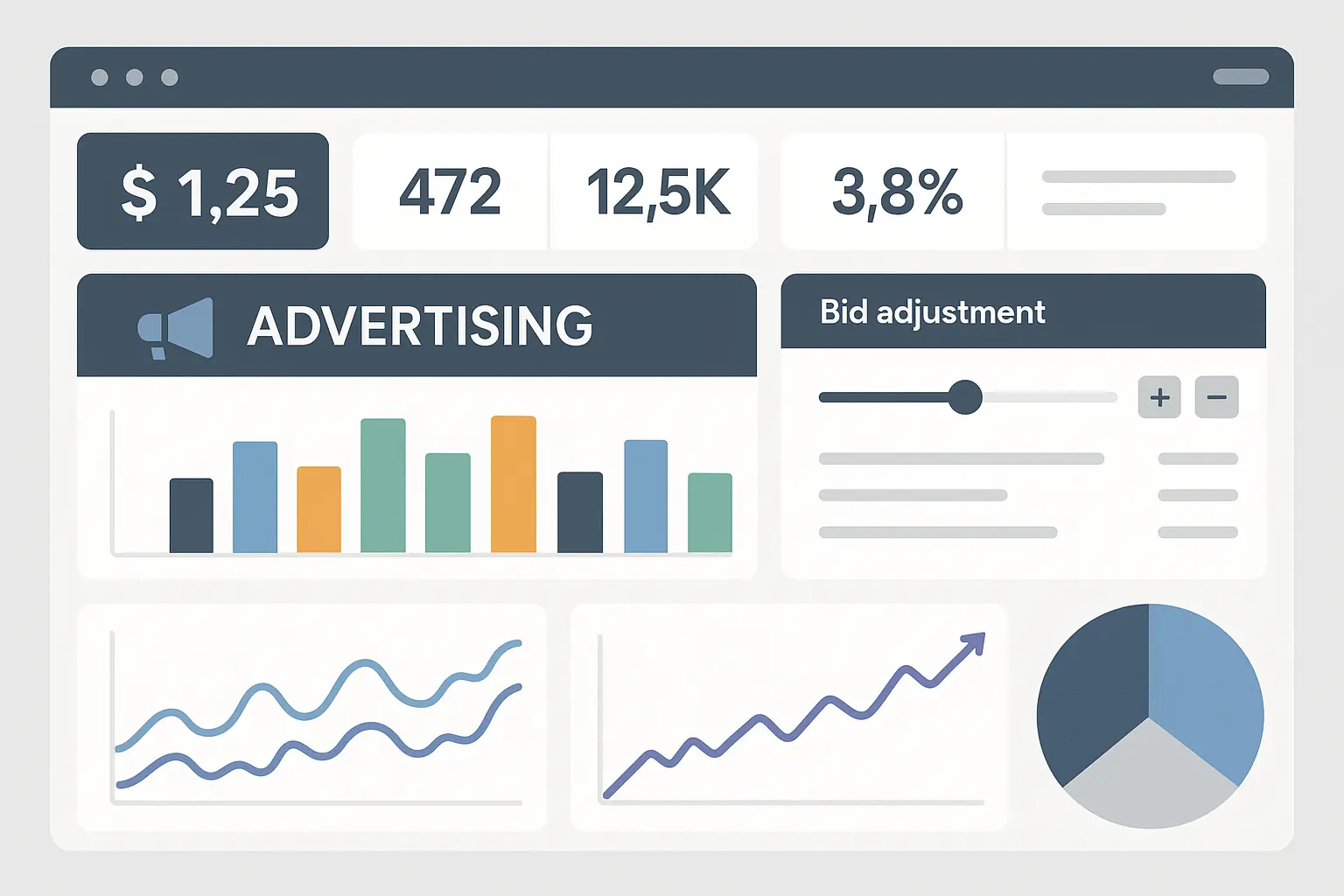
Paid ads are where you can get results fast – if you know what you’re doing. Mess it up, and you’re basically setting money on fire. I’ve done both, and let me tell you, the second one hurts.
16. PPC for Immediate User Acquisition
When you need customers yesterday, PPC is your answer. But “immediate” doesn’t mean “easy.” I’ve seen businesses blow through their entire marketing budget in a week because they thought PPC was just “set it and forget it.”
Campaign setup is like building a house – if your foundation sucks, everything else falls apart. Keywords, audiences, budgets, ad copy – they all need to work together. Miss one piece, and you’re paying for clicks from people who will never buy from you.
Smart bidding is Google’s way of using AI to optimize your bids. It works, but only if you give it good data to work with. Garbage in, garbage out.
Ad copy optimization involves testing headlines, descriptions, and calls-to-action to improve click-through rates and conversion rates. Landing page alignment ensures message consistency from ad click through conversion.
Why this topic works: Businesses with immediate growth needs will pay premium prices for expertise that delivers results quickly.
17. Advanced Google Ads Optimization
This is for people who’ve moved beyond “beginner” and want to squeeze every penny of performance out of their campaigns. We’re talking audience layering, negative keyword sculpting, and bid strategy optimization that actually moves the needle.
Smart bidding strategies leverage Google’s machine learning to optimize for specific business outcomes. Target CPA, target ROAS, and maximize conversions each serve different business objectives and require different optimization approaches.
Audience layering combines demographic, interest, and behavioral targeting for precise reach. Custom audiences based on website behavior, customer lists, and lookalike modeling improve campaign relevance and performance.
The difference between basic and advanced Google Ads management is like the difference between driving a car and racing Formula 1. Same basic concept, completely different skill level required.
Why this topic works: Advanced practitioners have bigger budgets and pay higher fees for specialized expertise.
18. Facebook and Social Media Advertising Trends
Social media advertising changes faster than fashion trends. What worked last year might be completely irrelevant today. iOS privacy updates, algorithm changes, new ad formats – you need to stay current or get left behind.
I watched a client’s Facebook ads completely tank overnight when iOS 14.5 dropped. The ones who adapted quickly survived. The ones who didn’t… well, let’s just say they’re not clients anymore.
FashionForward Boutique is a perfect example. Instead of fighting the privacy changes, they embraced them. Instead of relying on detailed demographic targeting, they focused on creative testing and lookalike audiences based on their highest-value customers. This approach resulted in a 23% reduction in cost-per-acquisition and 35% increase in return on ad spend within four months, proving that privacy-first advertising strategies can actually improve performance when implemented correctly.
Platform updates constantly change advertising capabilities, targeting options, and creative requirements. Staying current with Facebook, Instagram, TikTok, and LinkedIn changes ensures optimal campaign performance and compliance.
Why this topic works: High search volume from advertisers trying to keep up with constant changes.
19. Attribution Modeling for Paid Campaigns
Here’s the truth nobody wants to admit: most attribution is broken. You’re probably giving too much credit to your last-click campaigns and not enough to your awareness efforts.
The customer journey isn’t a straight line. Someone might see your Facebook ad, Google your brand name, read three blog posts, get your email newsletter, and then finally convert from a retargeting ad. Which campaign gets the credit?
Cross-device tracking makes this even more complicated. Research on mobile, convert on desktop. The tools are getting better, but you still need to understand the limitations.
Assisted conversion analysis shows how campaigns work together to drive results. Upper-funnel campaigns may not show direct conversions but significantly influence lower-funnel performance and overall campaign success.
Why this topic works: Accurate attribution is the holy grail of digital marketing. Solve this problem, and businesses will pay well for the solution.
Customer Retention & Email Marketing Topics

Getting new customers is expensive. Keeping the ones you have? That’s where the real money is. Email marketing might not be sexy, but it pays the bills.
20. Email Marketing ROI Maximization
Email marketing has the highest ROI of any marketing channel, but most people are doing it wrong. They’re sending the same generic newsletter to everyone and wondering why nobody opens it.
Segmentation is everything. Your customers who bought once need different emails than your customers who buy monthly. Your B2B audience wants different content than your B2C audience. One size fits nobody.
Automation is where the magic happens. Welcome sequences, abandoned cart emails, win-back campaigns – they work while you sleep. Set them up once, profit forever.
Deliverability optimization ensures emails reach subscriber inboxes rather than spam folders. Authentication protocols, list hygiene, and engagement monitoring maintain sender reputation and email performance.
Why this topic works: Email marketing directly impacts revenue, and the ROI is easy to measure and prove.
21. Customer Lifetime Value Optimization
Most businesses are obsessed with getting new customers and completely ignore the ones they already have. Big mistake. Your existing customers are your most profitable growth opportunity.
|
CLV Strategy |
How Long It Takes |
What You Can Expect |
How Hard Is It |
What To Track |
|---|---|---|---|---|
|
Email Segmentation |
2-4 weeks |
15-25% boost in email revenue |
Pretty easy |
Open rates, clicks, revenue per email |
|
Loyalty Programs |
2-3 months |
20-30% increase in repeat purchases |
Medium effort |
How often people buy again, average order size |
|
Personal Recommendations |
1-2 months |
10-20% more revenue |
Medium effort |
Cross-sell success, upsell revenue |
|
Stop-Churn Campaigns |
3-6 weeks |
25-40% fewer people leaving |
Harder to do right |
Churn rate, retention rate |
Predictive CLV modeling sounds fancy, but it’s really just using your data to predict which customers will be most valuable. Then you can spend more to acquire similar customers and invest more in keeping your best ones happy.
Retention campaigns target at-risk customers with personalized offers and engagement strategies. Churn prediction algorithms identify customers likely to leave, enabling proactive retention efforts before cancellation occurs.
Why this topic works: CLV optimization directly impacts profitability, and most businesses are leaving money on the table.
22. Inbound Marketing for Customer Journey Oversight
Inbound marketing is about being helpful instead of pushy. Instead of interrupting people with ads, you create content that helps them solve problems. When they’re ready to buy, guess who they think of?
Lead scoring helps you figure out who’s actually interested versus who’s just browsing. Someone who downloaded your pricing guide and visited your features page three times is probably more qualified than someone who read one blog post.
The handoff between marketing and sales is where most businesses drop the ball. Marketing generates leads, sales complains they’re not qualified, marketing complains sales isn’t following up. Sound familiar?
Progressive profiling gradually collects customer information through multiple touchpoints rather than overwhelming prospects with lengthy forms. This approach improves conversion rates while building comprehensive customer profiles over time.
Why this topic works: It addresses the complete customer journey, which is exactly what businesses need help with.
Industry Insights & Trends Topics
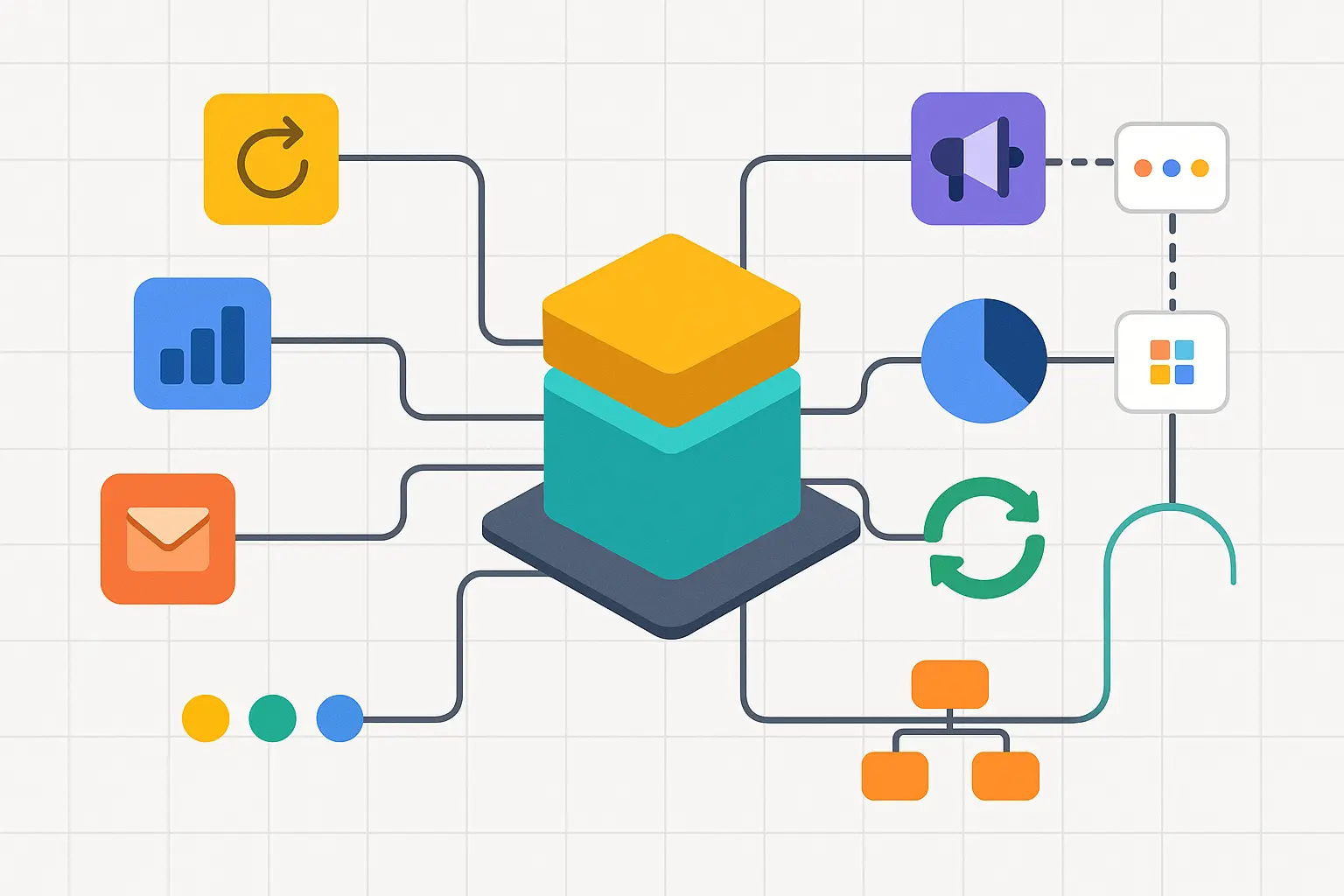
Trend topics are tricky. Get them right, and you’ll get massive traffic. Get them wrong, and you’re just adding to the noise. The key is having actual insights, not just repeating what everyone else is saying.
23. Digital Marketing Trends for 2025
Privacy-first marketing isn’t a trend – it’s the new reality. Third-party cookies are dying, iOS is blocking tracking, and consumers actually care about their data now. The businesses that adapt will thrive. The ones that don’t… well, good luck with that.
Voice search is changing how people find information. Instead of typing “best pizza NYC,” they’re asking “Hey Google, where’s the best pizza near me?” Your SEO strategy needs to account for conversational queries.
Marketers exploring emerging search technologies should consider implementing generative engine optimization strategies to ensure their content remains visible and authoritative across AI-powered search platforms and voice-activated devices.
Interactive content is having a moment because people are tired of being talked at. They want to participate. Polls, quizzes, calculators – anything that gets people engaged instead of just consuming.
Why this topic works: High seasonal search volume during planning season, and everyone wants to know what’s coming next.
24. Industry-Specific Marketing Strategies
SaaS marketing is completely different from e-commerce marketing, which is completely different from healthcare marketing. Generic advice doesn’t work when every industry has unique challenges.
SaaS companies need to focus on free trials and product demos. Long sales cycles require extensive nurturing and multiple touchpoints before conversion decisions.
E-commerce businesses live and die by seasonal campaigns and personalization. Recommendation engines significantly impact conversion rates and average order values.
Healthcare has to navigate compliance while building trust. HIPAA regulations, educational content, and professional credibility matter more than emotional appeals.
Why this topic works: Industry-specific content attracts highly qualified traffic and positions you as a specialist rather than a generalist.
25. Marketing Technology Stack Optimization
Most businesses have too many marketing tools that don’t talk to each other. You’ve got your CRM, your email platform, your analytics, your social media scheduler – and none of them share data. It’s a mess.
Businesses implementing comprehensive marketing technology stacks should explore AI search engine optimization tools to ensure their content strategy leverages the latest technological advances for maximum search visibility and performance measurement.
CRM integration with marketing automation platforms creates seamless lead handoff and customer journey tracking. API connections enable data flow between systems while maintaining data accuracy and reducing manual work.
Data warehouse setup centralizes customer information from multiple sources, enabling comprehensive attribution analysis and customer insights. Proper data architecture supports advanced analytics and machine learning applications.
Tool consolidation isn’t just about saving money (though that’s nice). It’s about having clean data that actually tells you what’s working. When everything’s connected, you can see the complete customer journey instead of fragments.
Why this topic works: Technical decision-makers are actively looking for solutions to streamline their operations and reduce costs.
Performance Analysis: High-Impact vs. Quick-Win Topics
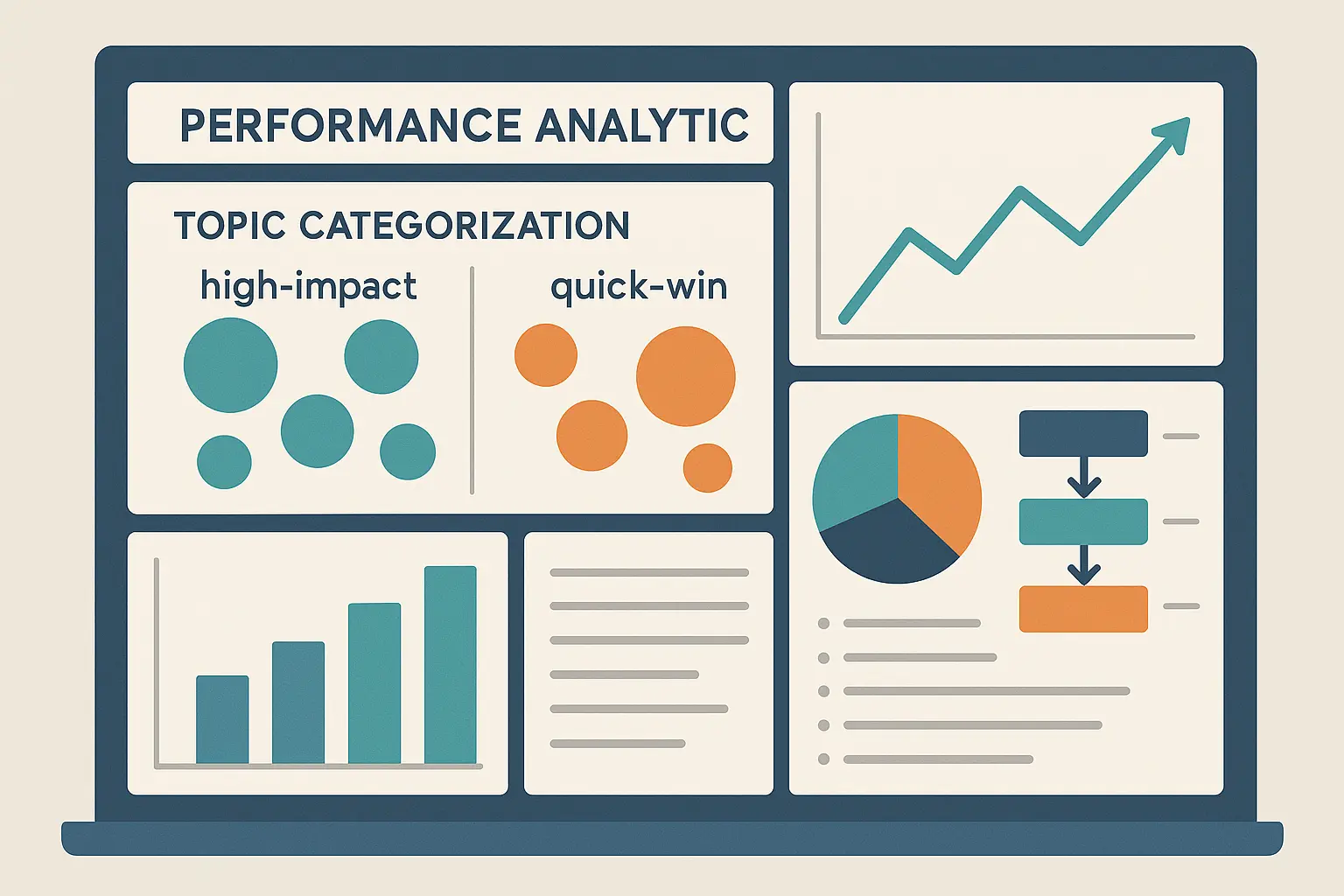
Not all topics are created equal. Some will build your authority over time, others will drive immediate traffic. You need both, but you should know which is which.
High-Performance Topics are your long-term investments:
LLM Optimization is where the smart money is going. Most people don’t understand it yet, which means low competition and high opportunity for early adopters.
Data-Driven Decision Making builds serious authority. When you can show executives how to make better decisions with data, they listen. And they pay.
ROI Measurement attracts people with budgets and buying authority. These aren’t casual browsers – they’re decision-makers looking for solutions.
SEO for Long-Term Sustainable Growth provides consistent organic traffic opportunities with evergreen appeal. The comprehensive nature allows for extensive content development and internal linking opportunities.
Quick-Win Topics get you traffic fast:
Digital Marketing Trends always spike during planning season. Easy to write, high traffic potential, great for social sharing.
AI-Powered Marketing Automation is hot right now. Everyone wants to know how to use AI without being replaced by it.
PPC topics attract people who need results yesterday and have budgets to make it happen.
Authority-Building Topics establish your expertise:
Marketing Attribution shows you understand the complex stuff that most marketers struggle with.
Performance Marketing Budget Allocation demonstrates strategic thinking and scientific approach.
Customer Lifetime Value Optimization proves you understand business fundamentals, not just marketing tactics.
How The Marketing Agency Leverages These Topics
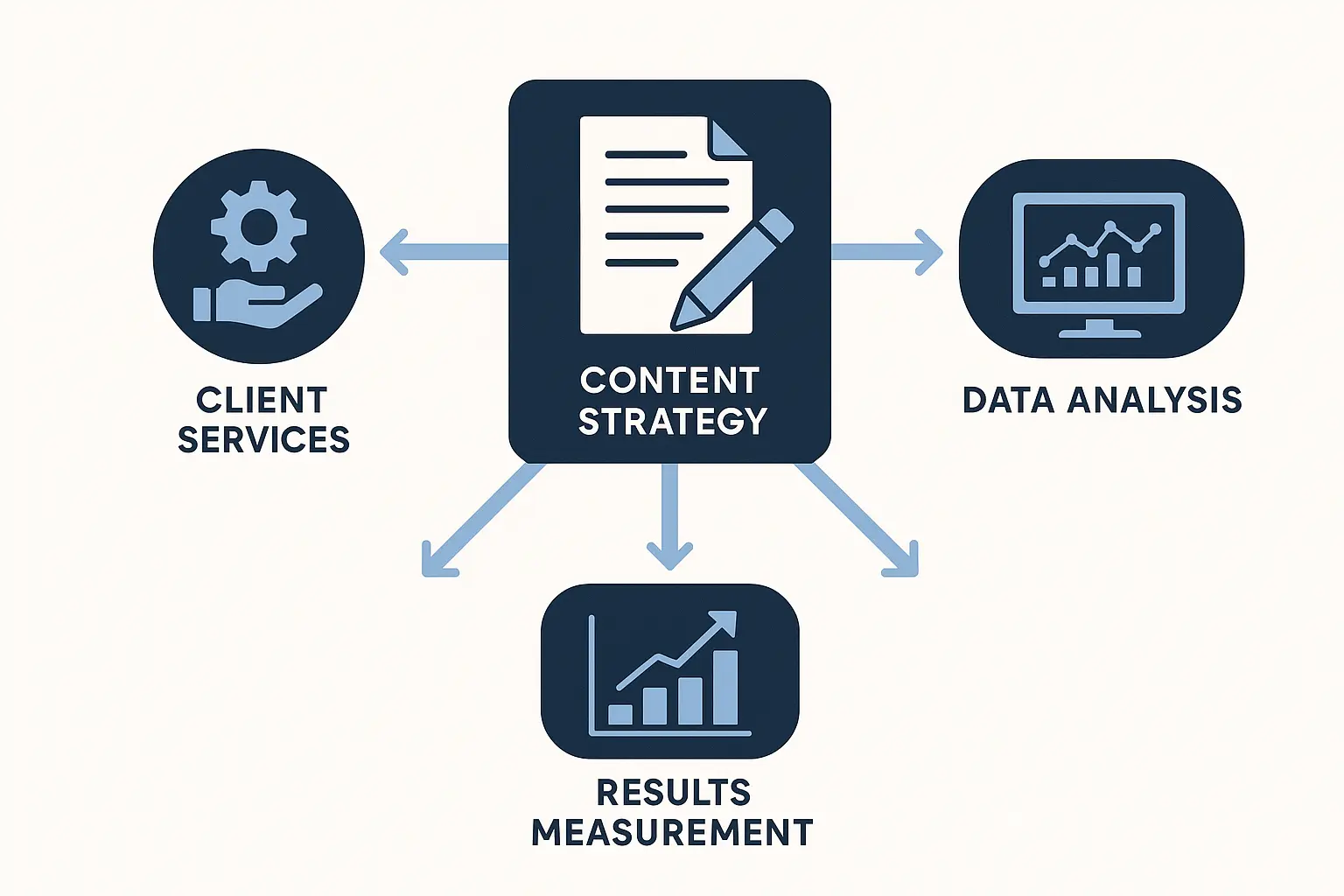
Here’s the thing about positioning – it only works if you actually live it. The Marketing Agency’s “data-driven” approach isn’t just marketing speak. It shows up in every piece of content, every client interaction, every result they deliver.
The Marketing Agency’s approach to creating continuously learning systems with AI demonstrates how advanced technology integration enhances traditional marketing methodologies while providing measurable performance improvements for clients.
Your scientific methodology naturally aligns with topics like data-driven frameworks and performance measurement. When prospects are tired of agencies that can’t prove their results, you become the obvious choice.
The AI integration stuff positions you ahead of the curve. While other agencies are still figuring out ChatGPT, you’re already implementing LLM optimization and advanced attribution modeling.
Your “real data, real results” positioning directly addresses the biggest complaint about agencies: lack of transparency. When someone’s current agency can’t explain why their campaigns aren’t working, your content shows exactly how you’d diagnose and fix the problem.
For clients asking “New product to market?” your scaling strategies and user acquisition topics provide immediate value while showcasing your ability to drive rapid, measurable growth. The scientific methodology you apply to campaign optimization becomes a clear differentiator from agencies relying on guesswork.
When prospects say “Not sure where to start?” your foundational strategy and framework topics establish trust while demonstrating comprehensive expertise. These educational pieces naturally lead to discovery calls where you can apply your diagnostic approach to their specific challenges.
Each topic category maps to your services. SEO content demonstrates long-term growth expertise. PPC topics show immediate results capability. Email marketing proves you can maximize existing customer value. It’s comprehensive without being scattered.
The measurement focus embedded in every topic reinforces your positioning while providing content performance data you can actually use. You’re not just creating content – you’re demonstrating your methodology.
My recommendation: Start with your strongest expertise areas. AI and attribution topics will establish thought leadership quickly. Then expand into broader business strategy content to capture wider audiences. Build authority systematically while generating qualified leads consistently.
Final Thoughts
Look, content marketing isn’t rocket science, but it’s not easy either. These 25 topics work because they solve real problems for real people with real budgets. The magic isn’t in the topics themselves – it’s in the execution.
Pick topics that match your expertise and resources. Don’t try to write about advanced attribution modeling if you’ve never run a multi-channel campaign. Authenticity beats ambition every time.
The best content strategy combines evergreen topics that drive consistent traffic with trending topics that capture current interest. You need both steady growth and occasional spikes.
Remember, topic selection is just the starting point. Quality execution, smart promotion, and conversion optimization determine whether your content investment pays off. Focus on being genuinely helpful while naturally guiding readers toward your solutions.
Your content strategy should evolve based on what actually works, not what you think should work. Track everything – traffic, engagement, leads, conversions. The data will tell you which topics resonate with your audience and generate the best results.
Most importantly, don’t try to cover all 25 topics at once. Pick 2-3 per month that align with your expertise and business goals. Quality beats quantity every single time. Better to nail a few topics than to half-ass a bunch of them.
And here’s something nobody talks about – some of your best content will come from your biggest failures. That campaign that tanked? The strategy that backfired? Those make for incredibly valuable case studies because everyone else is only sharing their wins.
The businesses winning with content marketing aren’t necessarily the ones with the biggest budgets or the fanciest tools. They’re the ones that consistently provide value, measure what matters, and adjust based on results. Pretty simple concept, but most people never actually do it.
So pick your topics, create something valuable, and see what happens. Then do more of what works and less of what doesn’t. Revolutionary, I know.



